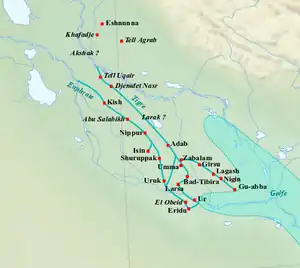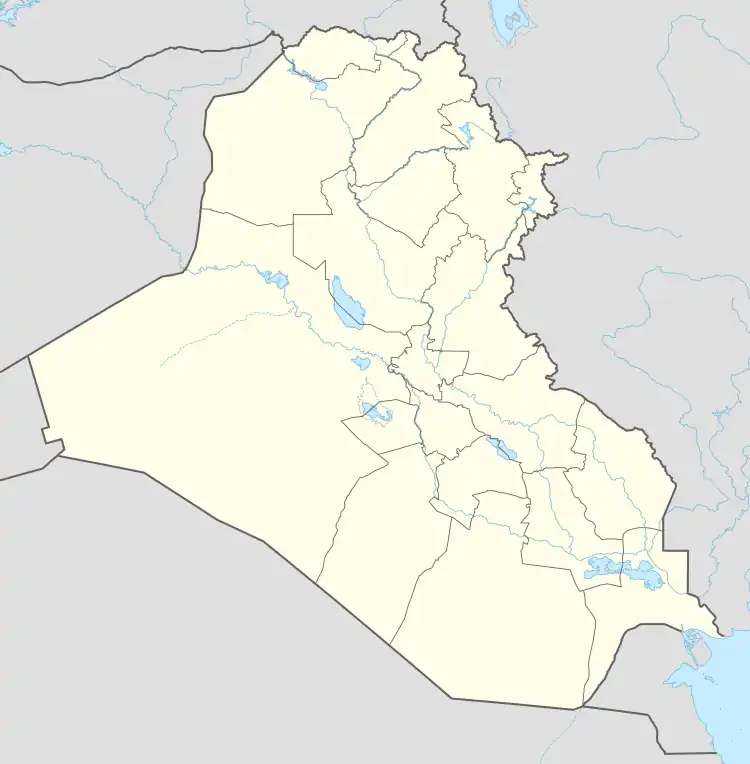Abu Salabikh
The low tells at Abu Salabikh, around 20 km (12 mi) northwest of the site of ancient Nippur and about 150 kilometers southeast of the modern city of Baghdad in Al-Qādisiyyah Governorate, Iraq mark the site of a small Sumerian city state of the mid third millennium BCE,[1] with cultural connections to the cities of Kish, Mari and Ebla.[2][3][4] Its contemporary name is uncertain: perhaps this was Eresh.[5] Kesh was suggested by Thorkild Jacobsen before excavations began.[6] The Euphrates was the city's highway and lifeline; when it shifted its old bed (which was identified to the west of the Main Mound by coring techniques), in the middle third millennium BCE, the city dwindled away. Only eroded traces remain on the site's surface of habitation after the Early Dynastic Period.[7] The site consists of several mounds, the 12 hectare wall enclosed Main (Early Dynastic), the 10 hectare Uruk and Jemdet Nasr, the West, and the 8 hectare South. An examination of the smaller outlying sites showed there was also occupation in the Sasanian, Seleucid, Parthian, and Kassite periods.[8]
 | |
 Shown within Iraq | |
| Location | Al-Qādisiyyah Governorate, Iraq |
|---|---|
| Region | Mesopotamia |
| Coordinates | 32°16′00″N 45°05′00″E |
| Type | Settlement |
| History | |
| Founded | Early Uruk period |
| Site notes | |
| Excavation dates | 1963-65, 1975–90 |
| Archaeologists | Donald P. Hansen, Nicholas Postgate |
Archaeology
Abu Salabikh was excavated by an American expedition from the Oriental Institute of Chicago led by Donald P. Hansen in 1963 and 1965 for a total of 8 weeks. The expedition found around 500 tablets and fragments, containing some of the earliest ancient literature.[7][9][10] A number of animal remains were also found including domestic dog, lion, equid, pig, cattle, gazelle, caprines (sheep and goat), and antelope.[11] Remains of various birds were also found.[12]
The site was a British concern after 1975, under the direction of Nicholas Postgate for the British School of Archaeology in Iraq (1975–90).[13][14][15] Excavations were suspended with the Invasion of Kuwait (1990); "plans to resume fieldwork have now been abandoned in the light of current political conditions" Postgate reports.[16] The city, built on a rectilinear plan in the early Uruk period, revealed a small but important repertory of cuneiform texts on some 500 tablets, of which the originals were stored in the Iraq Museum, Baghdad.[17]Texts, comparable in date and content with texts from Shuruppak (modern Fara, Iraq) included school texts, literary texts,[18] word lists, and some administrative archives, as well as the Instructions of Shuruppak, a well-known Sumerian "wisdom' text of which the Abu Salabikh tablet is the oldest copy. A list of deities includes the oldest known mention of the Semitic god Baʿal.[19] Postgate's interdisciplinary approach was integrated under the broad aim of describing the daily life of a small Sumerian city, down to the lives of the simplest illiterate inhabitants.[20]
On the Uruk mound, which was abandoned after the Jemmdet Nasr period, 1650 high fired clay sickles were found.[21]
Two grain samples from the Middle Uruk layer of the Uruk Mound were accelerator radiocarbon dated with calibrated dates of 3520 ± 130 BC.[22] Calibration was based on that of Pearson.[23]
See also
References
- Shaw, Ian; Jameson, Robert (2002). "Abu Salabikh". A dictionary of archaeology. Oxford: Blackwell Publishing. ISBN 978-0-631-23583-5. OCLC 963777094.
- Moorey, P. R. S. (1981). "Abu Salabikh, Kish, Mari and Ebla: Mid-Third Millennium Archaeological Interconnections". American Journal of Archaeology. 85 (4): 447–448. doi:10.2307/504868. ISSN 0002-9114. JSTOR 504868. S2CID 191401637.
- Pettinato, G., "L’Atlante Geografico Del Vicino Oriente Antico Attestato Ad Ebla e Ad Abū Şalābīkh (I)", Orientalia, vol. 47, no. 1, pp. 50–73, 1978
- Pomponio, Francesco, "Notes on the Lexical Texts from Abū Salābīkh and Ebla", Journal of Near Eastern Studies, vol. 42, no. 4, pp. 285–90, 1983
- Matthews, Roger (2003). The archaeology of Mesopotamia: theories and approaches. London; New York: Routledge. ISBN 978-0-415-25316-1. OCLC 50252068.
- Biggs, Robert D., "An Archaic Sumerian Version of the Kesh Temple Hymn from Tell Abū Ṣalābīkh", vol. 61, no. 2, pp. 193-207, 1971
- Biggs, Robert D. (1974). Inscriptions from Tell Abū Ṣalābīkh (PDF). Donald P. Hansen. Chicago: University of Chicago Press. ISBN 0-226-62202-9. OCLC 1170564.
- Wilkinson, T. J., "Early Channels and Landscape Development around Abu Salabikh, a Preliminary Report", Iraq, vol. 52, pp. 75–83, 1990
- Alster, Bendt, "Early Dynastic Proverbs and Other Contributions to the Study of Literary Texts From Abū Ṣalābīkh", Archiv Für Orientforschung, vol. 38/39, pp. 1–51, 1991
- Alberti, A., "A Reconstruction of the Abu Salabikh God-list", Studi Epigraphici e linguistici sul Vicino Oriente 2, pp. 3–23, 1985
- Clutton-Brock, Juliet, and Richard Burleigh, "The Animal Remains from Abu Salabikh: Preliminary Report", Iraq, vol. 40, no. 2, pp. 89–100, 1978
- EASTHAM, ANNE, "THE BIRD BONES FROM ABU SALABIKH", Iraq, vol. 71, pp. 99–114, 2009
- Nicholas Postgate, "Excavations at Abu Salabikh 1976", Iraq, vol. 39, pp. 269–299, 1977
- Nicholas Postgate, "Excavations at Abu Salabikh 1977", Iraq, vol. 40, pp. 89-100, 1978
- Nicholas Postgate, "Excavations at Abu Salabikh 1978-79", Iraq, vol. 42, no. 2, pp. 87–104, 1980
- Prof. Nicholas Postgate : Postgate turned his attention to the multiperiod site at Kilise Tepe, in the province of Mersin in southern Turkey.
- M. Krebernik and J. N. Postgate, "The tablets from Abu Salabikh and their provenance", Iraq, vol. 71, pp. 1- 32, 2009
- "We are now able to behold the earliest creative period of Sumerian belles lettres", remarked Mark E. Cohen in 1976 (Cohen, "The Name Nintinugga with a Note on the Possible Identification of Tell Abu Salābīkh" Journal of Cuneiform Studies, 28.2 [April 1976:82–92]). Cohen identifies the contemporaneous name of the city, from the "zà-mì hymns", as Gišgikidu, "Gišgi, the good place".
- Toorn, K. van der; Becking, Bob; Horst, Pieter Willem van der (1999). "Baal". Dictionary of deities and demons in the Bible: DDD. Leiden; Grand Rapids, Mich: Brill : Eerdmans. ISBN 978-90-04-11119-6. OCLC 1005995268.
- Postgate summarized the discoveries at Abu Salabikh in the relevant article in J. Curtis, ed., Fifty Years of Mesopotamian Discovery(London) 1982:48–61.
- BENCO, Nancy L., "MANUFACTURE AND USE OF CLAY SICKLES FROM THE URUK MOUND, ABU SALABIKH, IRAQ", Paléorient, vol. 18, no. 1, pp. 119–34, 1992
- Susan Pollock, Caroline Steele and Melody Pope, Investigations on the Uruk Mound, Abu Salabikh, 1990, Iraq, vol. 53, pp. 59–68, 1991
- Pearson, G. W. et al., 1986. High precision 14C measurement of Irish oaks to show the natural 14C variation from a.d. 1840 to 5210 b.c. Radiocarbon 28, pp. 911-34, 1986
Further reading
- Matthews, R. and Matthews, W. (2017) A palace for the king of Eres? Evidence from the Early Dynastic City of Abu Salabikh, south Iraq. In: Heffron, Y., Stone, A. and Worthington, M. (eds.) At the dawn of history. Ancient Near Eastern studies in honour of J. N. Postgate. Eisenbrauns, Winona Lake, pp. 359–367. ISBN 9781575064710
- Wencel, M., "ABU SALABIKH – ABSOLUTE RADIOCARBON CHRONOLOGY.", Iraq, vol. 83, pp. 245–258, 2021 doi:10.1017/irq.2021.7
- Robert D. Biggs, The Abu Salabikh Tablets. A Preliminary Survey, Journal of Cuneiform Studies, vol. 20, no. 2, pp. 73–88, 1966
- CRAWFORD, Harriet E. W., "SOME FIRE INSTALLATIONS FROM ABU SALABIKH, IRAQ (Dedicated to the Memory of Margaret Munn-Rankin)", Paléorient, vol. 7, no. 2, pp. 105–14, 1981
- Crawford, H. E. W., "More Fire Installations from Abu Salabikh", Iraq, vol. 45, no. 1, pp. 32–34, 1983
- Angela von den Driesch, "Fischknochen Aus Abu Salabikh/Iraq", Iraq, vol. 48, pp. 31–38, 1986
- JONES, Jennifer E., "Standardized Volumes? Mass-Produced Bowls of the Jemdet Nasr Period from Abu Salabikh, Iraq", Paléorient, vol. 22, no. 1, pp. 153–60, 1996
- Postgate, J. N., and Moorey, P. R. S., "Excavations at Abu Salabikh, 1975", Iraq, vol. 38, pp. 133–69, 1976
- Moon, Jane, "Some New Early Dynastic Pottery from Abu Salabikh", Iraq, vol. 43, no. 1, pp. 47–75, 1981
- Payne, Joan Crowfoot, "An Early Dynastic III Flint Industry from Abu Salabikh", Iraq, vol. 42, no. 2, pp. 105–19, 1980
- POLLOCK, S., "POLITICAL ECONOMY AS VIEWED FROM THE GARBAGE DUMP : JEMDET NASR OCCUPATION AT THE URUK MOUND, ABU SALABIKH", Paléorient, vol. 16, no. 1, pp. 57–75, 1990
- Pollock, Susan, "Making Fire in Uruk-Period Abu Salabikh", At the Dawn of History: Ancient Near Eastern Studies in Honour of J. N. Postgate, edited by Yağmur Heffron, Adam Stone and Martin Worthington, University Park, USA: Penn State University Press, pp. 413-422, 2017
- Nicholas Postgate and J.A. Moon, "Excavations at Abu Salabikh 1981", Iraq, vol. 44, no. 2, pp. 103–136, 1982
- Nicholas Postgate, "Excavations at Abu Salabikh 1983", Iraq, vol. 46, pp. 95–114, 1984
- Postgate, J. N. - Killick, J. A., "British Archaeological Expedition to Abu Salabikh, Final Field Report on the 8th Season", Sumer, vol. 39, pp. 95-99, 1983
- R.J. Matthews and Nicholas Postgate, "Excavations at Abu Salabikh 1985-86", Iraq, vol. 49, pp. 91–120, 1987
- Nicholas Postgate, "Excavations at Abu Salabikh 1988-89", Iraq, vol. 52, pp. 95–106, 1990
- S. Pollock, M. Pope and C. Coursey, "Household Production at the Uruk Mound, Abu Salabikh, Iraq," American Journal of Archaeology, vol. 100, no. 4, pp. 683–698, 1996
- Nicholas Postgate, “Early Dynastic burial customs at Abu Salabikh”, in Sumer 36, pp. 65–82, 1980
- Postgate J.N. and Moon J.A., Excavations at Abu Salabikh, a Sumerian city, National Geographic Research Reports: 1976 projects, vol. 17, pp. 721–743, 1984
- Unger-Hamilton, Romana, et al., "Drill bits from Abu Salabikh, Iraq", MOM Éditions 15.1, pp. 269-285, 1987
- Abu Salabikh Excavations:
- Volume I - J.N. Postgate, "The West Mound Surface Clearance",Oxbow Books, 1983 ISBN 0903472066 PDF
- Volume II - H.P. Martin, J. Moon & J.N. Postgate, "Graves 1 to 99", Oxbow Books, 1985 ISBN 9780903472098 PDF
- Volume III - Jane Moon, "Catalogue of Early Dynastic Pottery", Oxbow Books, 1987 ISBN 9780903472111 PDF
- Volume IV - A.N. Green, "The 6G Ash-Tip and its Contents: Cultic and Administrative Discard from the Temple?", Oxbow Books, 1993 ISBN 9780903472135 PDF